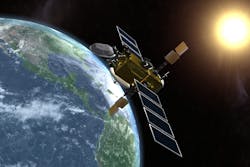Space Force eyes space nuclear power for propulsion and payloads on future small reconnaissance satellites
KIRTLAND AIR FORCE BASE, N.M. – U.S. Space Force space experts are reaching out to industry for new ideas in space nuclear power generation for future propulsion and sensor payloads aboard small satellites.
Officials of the U.S. Air Force Research Laboratory Space Vehicle Directorate at Kirtland Air Force Base, N.M., issued an advanced research announcement (FA9453-21-S-0001-CALL-007) on Tuesday for the Joint Emergent Technology Supplying On-Orbit Nuclear power (JETSON) Low Power Mission Application project.
JETSON, which is part of the Space Technology Advanced Research - Fast-tracking Innovative Software and Hardware (STAR-FISH) initiative, seeks to develop enabling technologies for space-based radioisotope power systems.
Researchers are looking for new ways to develop compact radioisotope power systems, electric and hybrid propulsion for power conversion, power management, on-orbit mobility, thermal regulation, deployable structures, radiation shielding, and electronic hardening.
Related: Radiation hardening meets smart satellites
Today's pace systems are evolving from a few exquisite satellites to proliferated systems for persistent communications; intelligence, surveillance, and reconnaissance; positioning navigation and timing; space domain awareness; and space power.
The continuous power levels obtainable using space nuclear power may provide advantages over current solar electric power for mission payloads and spacecraft -- especially those relying on high delta-V electric propulsion, researchers explain.
Space nuclear power could enable a new generation of military small low-power applications that are not possible today. Work will involve integrating subsystem components, assessing technology readiness levels, component risk-reduction demonstrations, and model-based systems engineering models of a combined system of systems that uses space nuclear power.
Related: Space: the next frontier of rad-hard
The ideal design should balance electrical production with thermal dissipation overhead to reduce risk for near-term thermal radiator development for a navigation beacon in support of cislunar operations near NASA’s GATEWAY -- a future multi-purpose outpost orbiting the moon.
Such a system, which would be a 1U design that consumes five Watts or less, should be able to display orbital agility via a propulsion system able to operate for one year of mission operations, and for as long as two years of extended mission operations. Electric propulsion may consume as much as 15 Watts of power.
Researchers do not intend to limit consideration to traditional cubesat dimensions, but prefer small spacecraft. The system will incorporate cyber security and DEVSECOPS, AND Test software should be designed to incorporate these concepts.
Related: Electronics in space: traditional market faces-off against new space
Companies interested should submit white papers no later than 17 Feb. 2023 via DOD Safe at https://safe.apps.mil. Those submitting white papers should use the template available online at https://valideval.com/star_documents/. Companies submitting promising white papers may be invited to submit full proposals.
Email questions or concerns to Lt. Col. Thomas Nix, the JETSON technical manager, at [email protected]; Michael Lopez, the JETSON program manager at [email protected]; Shawn Capehart, the JETSON contracting officer at [email protected].
More information is online at https://sam.gov/opp/bbe6876459bc4bec85685fb561cbaaf7/view.
About the Author
John Keller
Editor-in-Chief
John Keller is the Editor-in-Chief, Military & Aerospace Electronics Magazine--provides extensive coverage and analysis of enabling electronics and optoelectronic technologies in military, space and commercial aviation applications. John has been a member of the Military & Aerospace Electronics staff since 1989 and chief editor since 1995.
